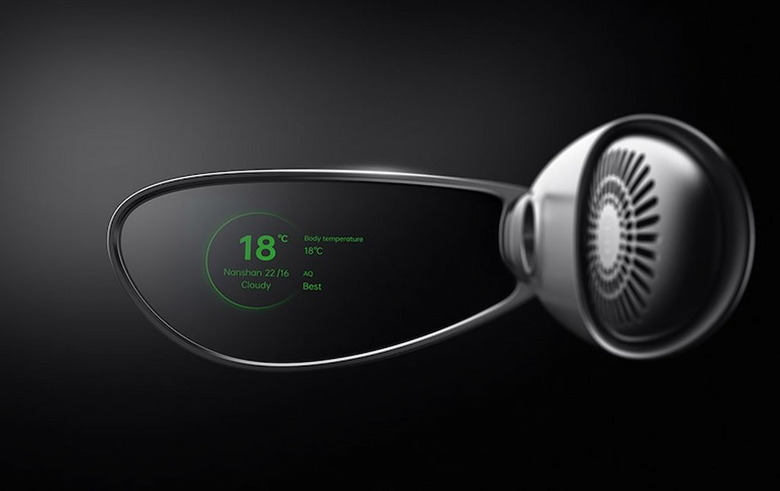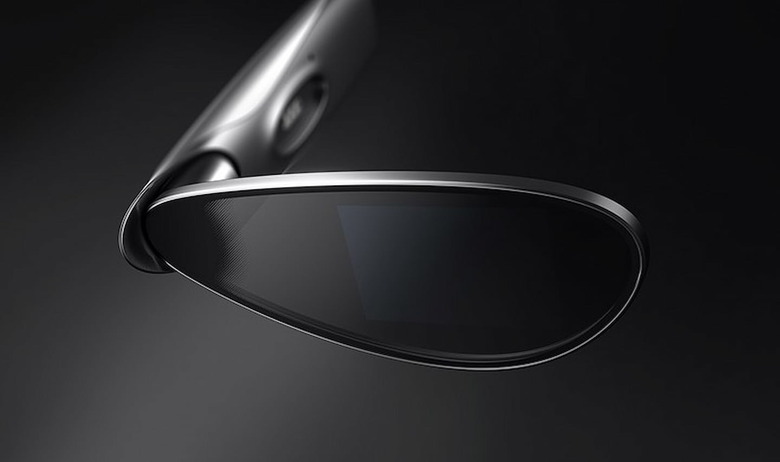OPPO Air Glass Delivers Alternative To AR With 'Assisted Reality'
Today at INNO Day 2021, OPPO revealed Air Glass, a new "assisted reality" wearable that isn't quite like the AR (augmented reality) glasses of the past. While our minds will likely jump to Google Glass or maybe even the Magic Leap One when talking about augmented reality headsets, the OPPO Air Glass looks quite a bit different from both of those products. For starters, OPPO Air Glass uses a detachable monocle design, but beyond that, it also seems to narrow the focus of AR glasses with a straightforward heads-up display and a small but useful collection of apps.
OPPO describes Air Glass as a "minimalist" device that uses a diffraction optical waveguide display and OPPO's in-house Spark Micro Projector, which uses Micro LED. The Air Glass uses only a single display (much like Google Glass) that can be magnetically attached to a frame, with OPPO announcing both full and half-frames for it today as well. The entire package weighs 30 grams and has a Snapdragon Wear 4100 powering the show.
OPPO says that the projector at the core of Air Glass is only about the size of a coffee bean, but when paired with the waveguide display, it can deliver up to 1,400 nits in average brightness. The display itself is sandwiched between two layers of sapphire glass and can output in 16-level or 256-level grayscale, so users probably won't get any fancy visuals out of this package.
That's okay, though, because that greyscale display is all the Air Glass needs to do what it was designed to do. OPPO says that the Air Glass can be paired with either an OPPO Watch 2 or any OPPO smartphone running ColorOS 11 or above. When used alongside the OPPO Watch 2, Air Glass can be controlled via hand movements, which is an interesting touch. Air Glass can also recognize head movements, with nods opening notifications and head shakes dismissing them.

Beyond head and hand movement controls, the Air Glass also supports touch controls and voice controls, as we'd expect any AR glasses to. The apps that will be available on Air Glass – at least at the start – will be few in number but useful nonetheless. We've got the usual suspects there, including weather, health, and calendar apps, but OPPO is also shipping a teleprompter app with the Air Glass, potentially making it a good companion for presentations.
Another notable app is the translation app, which will detect the voice of the person you're talking to, automatically translate what they're saying, and show that translation on the display. OPPO says that Air Glass will support Mandarin Chinese/English two-way translation at launch, with Mandarin Chinese/Japanese and Mandarin Chinese/Korean translation planned in the future.

Finally, Baidu is making a walking and biking navigation app for Air Glass that can give users directions on the display. Paired with Baidu's Explore Nearby app, Air Glass will even be able to tell users when there are stores or points of interest nearby.
OPPO might just be onto something here by paring back the AR wearable experience and turning it into more of an assistive technology. While Air Glass won't support a ton of different apps at launch, the few that it will support have a lot of potential in the AR space, so Air Glass could very well be a device to watch as we move through 2022. We'll see it launch in Q1 2022 in mainland China, with no other launch regions announced today.
